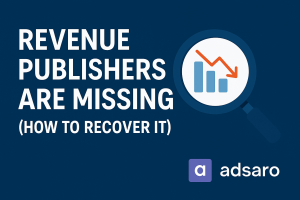Ad Quality Score is one of the most critical elements in digital advertising. It directly impacts your ad placement, cost-per-click (CPC), and overall campaign effectiveness. Whether you’re running ads on Google Ads, Meta Ads, or programmatic platforms, a strong Quality Score can lead to better performance and lower costs.
In this blog, we’ll break down what Ad Quality Score is, why it matters, how it’s calculated, and how you can improve it for better results.
What Is Ad Quality Score?
It is a metric used by advertising platforms to measure the relevance and effectiveness of your ads. It determines how well your ad matches user intent and how likely it is to provide a positive experience.
Different platforms have their own versions of Quality Score:
- Google Ads: Google Ads ranks ads on a scale from 1 to 10 based on expected click-through rate (CTR), ad relevance, and landing page experience.
- Meta Ads (Facebook & Instagram): Meta Ads uses “Ad Relevance Diagnostics,” including quality ranking, engagement rate ranking, and conversion rate ranking.
- Microsoft Ads: Similar to Google Ads, Microsoft Ads considers expected CTR, ad relevance, and landing page experience.
- Programmatic Platforms: DSPs like The Trade Desk and Xandr use machine learning to evaluate ad quality and engagement potential.
Why Ad Quality Score Matters for Campaign Performance
A high Score can significantly impact your campaign success. Here’s how:
| 1. Lower Cost Per Click (CPC) | Ad platforms reward high-quality ads with lower CPCs. If your ad is relevant and engaging, you’ll pay less per click than competitors with lower scores. |
| 2. Higher Ad Placement and Impressions | Quality Score affects where your ad appears. Higher scores improve your chances of securing premium placements on Google Search, social media feeds, and display networks. |
| 3. Better Conversion Rates | Since a good Quality Score indicates high relevance, users are more likely to engage with your ad and convert, improving ROI. |
| 4. Higher Ad Rank Without Increasing Budget | In competitive bidding environments, a strong Quality Score can boost your Ad Rank without requiring you to raise your bid amount. |
How Is Ad Quality Score Calculated?
While each platform has a slightly different algorithm, the core factors influencing Quality Score include:
| 1. Expected Click-Through Rate (CTR) | Measures how likely users are to click on your ad. Based on historical performance and relevance to search queries. |
| 2. Ad Relevance | Compares your ad copy to the target keywords or audience. Low relevance means lower engagement and a lower Quality Score. |
| 3. Landing Page Experience | Assesses whether your landing page is relevant, fast, and provides a good user experience. Google and Microsoft analyze page load speed, content relevance, and mobile-friendliness. |
| 4. Historical Ad Performance | Platforms track past ad performance, factoring in user engagement and conversion history. |
5 Best Practices to Improve Your Ad Quality Score
1. Optimize Your Ad Copy for Relevance
- Include target keywords naturally in your headlines and descriptions.
- Write compelling, action-driven copy that aligns with user intent.
- Example: Instead of “Best Shoes Online,” try “Buy Stylish Running Shoes – Free Shipping!”
2. Improve Your Click-Through Rate (CTR)
- Use power words and clear calls-to-action (CTAs).
- Experiment with different ad formats like Google Responsive Search Ads or Meta Carousel Ads to find the best-performing version.
3. Enhance Landing Page Experience
- Ensure your landing page matches the ad’s message and intent.
- Optimize page speed, navigation, and mobile responsiveness.
- Example: If you’re running a LinkedIn Ads campaign promoting B2B software, your landing page should have clear product benefits, testimonials, and a strong CTA.
4. A/B Test Your Ads Regularly
- Test different headlines, descriptions, and CTAs.
- Adjust based on performance data from platforms like Google Ads, Microsoft Ads, or The Trade Desk.
5. Focus on Audience Targeting
- Use demographic, interest-based, and behavioral targeting for precision.
- Platforms like Xandr and Meta Ads Manager allow advertisers to refine audience segments for higher engagement.
Final Thoughts
Ad Quality Score is a crucial factor in the success of your digital advertising campaigns. A higher score means lower costs, better placement, and higher conversions. By optimizing your ad copy, improving your landing pages, and refining audience targeting, you can boost your Score and maximize your campaign’s ROI.
If you’re running campaigns on Google, Meta, or programmatic platforms, understanding and improving Quality Score should be a top priority. Start optimizing today and see the impact on your ad performance!








Leave a Reply